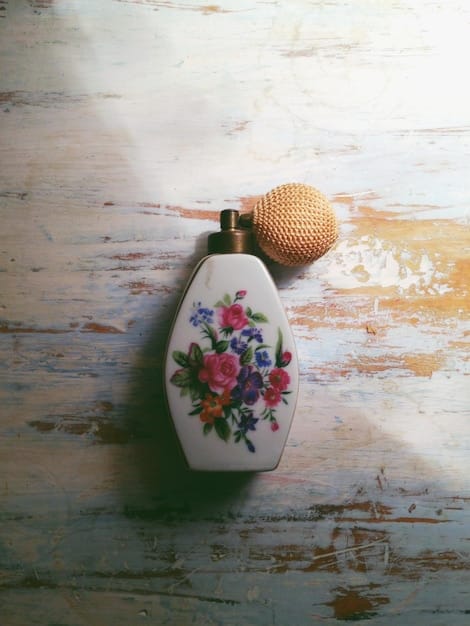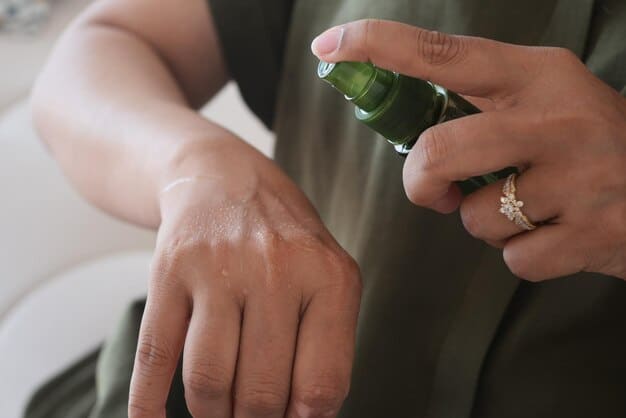Fragrance Layering 101: Craft Your Signature Scent This Season

Fragrance layering involves combining different scents to create a unique, personalized fragrance blend, allowing you to tailor your perfume to suit your mood, the season, or any occasion, transforming familiar fragrances into something entirely new and captivating.
Ready to discover the art of fragrance layering 101: create your signature scent combination this season? It’s all about mixing and matching different fragrances to craft a scent that’s uniquely yours. Let’s explore how you can become a master of personalized perfumes!
Understanding Fragrance Layering
Fragrance layering is the process of combining multiple fragrances on your skin to craft a unique and personalized scent. It’s like creating a custom blend tailored specifically to your preferences. By understanding the basics, you can master this creative process and develop scents that perfectly match your style and mood.
The Benefits of Layering Scents
Layering scents offers numerous advantages. It allows for a personalized fragrance experience, enhancing the longevity of your perfume, and creating unique combinations that stand out.
- Personalization: Tailor your scent to reflect your individuality.
- Longevity: Layering can help extend the life of your fragrance.
- Uniqueness: Create scent combinations that are truly one-of-a-kind.
Basic Fragrance Families
Understanding fragrance families is essential for successful layering. The primary families include floral, woody, oriental, and fresh. Each family has distinct characteristics that influence how they interact with other scents.
- Floral: Light and sweet, often used as a base layer.
- Woody: Earthy and grounding, adding depth to a blend.
- Oriental: Warm and spicy, providing richness and complexity.
- Fresh: Clean and crisp, ideal for adding a refreshing touch.
By understanding these basic fragrance families, you can begin to experiment with different combinations to achieve your desired scent profile, making your fragrance layering journey both enjoyable and successful.

Choosing Your Fragrances
Selecting the right fragrances for layering can seem daunting, but it’s a creative journey. Start by identifying the notes you love and considering how they might complement each other. Think about the base, middle, and top notes of each fragrance to create harmonious combinations.
Consider the Notes
Different fragrances have different notes. The base notes are the foundation of the scent, the middle notes provide the body, and the top notes offer the initial impression. Pairing complementary notes is key to a balanced layered fragrance.
Understanding these notes can help you predict how fragrances will interact, guiding your layering combinations effectively. Here’s a simplified view:
- Base Notes: Foundation of the scent, long-lasting (e.g., vanilla, sandalwood).
- Middle Notes: Heart of the fragrance, develops after the top notes fade (e.g., rose, lavender).
- Top Notes: Initial impression, short-lived (e.g., citrus, herbs).
Start with Similar Scents
Begin with fragrances that share similar scent profiles. Layering two different floral perfumes, or combining a woody scent with an oriental one, is a good starting point.
This approach helps ensure the fragrances blend seamlessly, creating a cohesive and appealing scent. For instance:
- Floral + Floral: Combining rose and jasmine fragrances.
- Woody + Oriental: Pairing sandalwood with amber.
- Citrus + Fresh: Layering lemon with sea salt.
Choosing fragrances with similar scent profiles sets the foundation for more adventurous combinations as you gain confidence and experience in fragrance layering.
Layering Techniques
Now that you’ve selected your fragrances, it’s time to learn the proper techniques for layering. The key is to apply the fragrances in the right order and to strategic points on your body. This ensures the scents blend well and last longer.
Layering Order
The general rule is to apply the heavier, stronger scents first and then layer lighter fragrances on top. This allows the lighter notes to shine without being overpowered.
By following this order, you can ensure that each fragrance contributes its unique character to the overall blend. Here’s a typical layering order:
- Heavier Scents: Apply woody or oriental fragrances first.
- Lighter Scents: Follow with floral or fresh scents.
Application Points
Apply fragrances to pulse points, where your body heat will help diffuse the scent. Common points include wrists, neck, and behind the ears.
Strategic application enhances the projection and longevity of the layered fragrance. Consider the following:
- Wrists: Allow the scents to blend naturally with movement.
- Neck: Create a subtle scent trail as you move.
- Behind the Ears: Enhance the fragrance’s warmth.
Creating Signature Combinations
Creating a signature fragrance combination is about finding the right balance of scents that reflect your personality and style. Experimentation is key, and it’s okay to make mistakes along the way. The goal is to discover a scent that feels uniquely you.
Experimenting with Contrasting Scents
Don’t be afraid to mix contrasting scents. Sometimes, unexpected combinations can create the most interesting fragrances. For example, pairing a fresh citrus with a warm vanilla can be both invigorating and comforting.
Embrace the possibility of discovering unique and unexpected pairings. Some examples include:
- Citrus and Vanilla: A refreshing and comforting blend.
- Floral and Spicy: Balancing sweet and warm notes.
- Woody and Fresh: Creating an earthy yet clean aroma.
Layering for Different Occasions
Consider the occasion when layering your fragrances. A lighter, fresher combination might be perfect for daytime, while a richer, more complex scent could be ideal for evening events.
Layering differently for various occasions allows you to adapt to your environment and mood. Consider these scenarios:
- Daytime: Opt for lighter scents like citrus and floral.
- Evening: Choose richer scents like oriental and woody.
- Special Events: Experiment with unique and complex blends.

Common Mistakes to Avoid
Fragrance layering can be a complex endeavor, and it’s easy to make mistakes. Avoiding these common pitfalls will help you create harmonious and long-lasting scent combinations that truly stand out. Be mindful of over-layering, neglecting scent families, and more.
Over-Layering
One of the most common mistakes is using too many fragrances at once. Over-layering can create a muddled scent that is overwhelming and unpleasant. Stick to two or three fragrances for the best results.
To avoid this mistake, remember to keep it simple and focus on quality over quantity. Here’s a simple breakdown:
- Limit Fragrances: Use no more than three scents.
- Assess the Blend: Step back and evaluate the combined aroma.
Ignoring Scent Families
Ignoring the relationships between scent families can result in clashing fragrances. Understanding how different families interact is crucial for creating balanced combinations. Combining too many disparate scents can lead to a chaotic and unbalanced result.
Take the time to learn about the basic scent families and their complementary pairings before experimenting. Here are some considerations:
- Learn the Basics: Understand floral, woody, oriental, and fresh families.
- Pair Wisely: Choose fragrances that complement each other.
Long-Lasting Layering Tips
To make your layered fragrance last longer, preparation and application are essential. Starting with moisturized skin, layering correctly, and understanding your fragrances, will help you increase the longevity of your layered scent. Ensure the right preparation and application for extended wear.
Moisturize Your Skin
Fragrances last longer on moisturized skin. Apply a scent-free lotion or oil before layering your fragrances to help them adhere better. Hydrated skin provides a better base for the fragrance to latch onto, preventing it from dissipating quickly.
By moisturizing your skin, you create an ideal canvas for layering your scents. Consider these points:
- Use Scent-Free Products: Avoid competing aromas.
- Apply Generously: Ensure skin is well-hydrated.
Layering Products
Use complementary scented products, like shower gels and lotions, from the same fragrance family to enhance the layering effect. This creates a more cohesive and long-lasting scent experience.
By incorporating these products into your routine, you build a strong foundation for your layered fragrance. Here are some examples:
- Shower Gel: Start with a base scent in the shower.
- Lotion: Apply a matching lotion post-shower.
| Key Point | Brief Description |
|---|---|
| ✨ Layering Benefits | Personalize scents, extend fragrance life, create unique combinations. |
| 💐 Fragrance Families | Floral, woody, oriental, and fresh families interact differently. |
| 📝 Layering Order | Apply heavier scents first, lighter scents on top for balanced aroma. |
| ✅ Mistakes to Avoid | Avoid over-layering and ignoring scent families for harmonious blends. |
FAQ
Fragrance layering is the technique of combining multiple fragrances to create a unique, personalized scent. It involves applying different scents in a specific order to achieve a desired complexity and depth.
Start by understanding the scent families. Choose fragrances with complementary notes. Experiment with combining floral, woody, oriental, and fresh scents to find combinations that appeal to you.
Generally, apply heavier scents first, followed by lighter scents on top. This allows the lighter notes to emerge gradually and prevents them from being overpowered by the stronger, heavier notes.
Moisturize your skin before applying fragrance to help it adhere better. Use complementary scented products like lotions and shower gels. Apply the fragrance to pulse points for maximum diffusion and longevity.
Avoid over-layering, which can result in a muddled scent. Also, avoid ignoring the relationships between scent families and ensure the chosen fragrances complement each other for a balanced and harmonious blend.
Conclusion
Mastering the art of fragrance layering 101: create your signature scent combination this season allows you to express your unique style and personality through scent. By understanding the basics of fragrance families, experimenting with different combinations, and avoiding common mistakes, you can create a fragrance that is truly your own.





